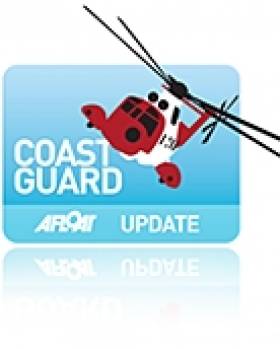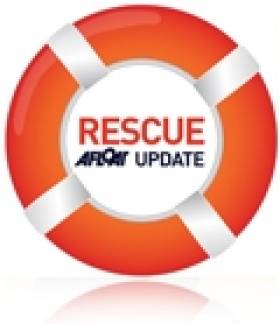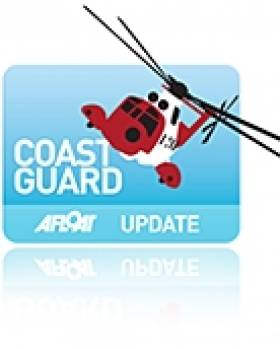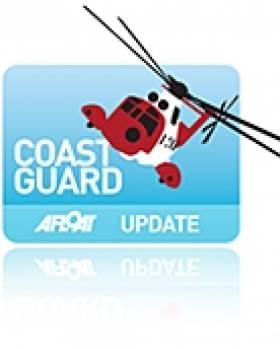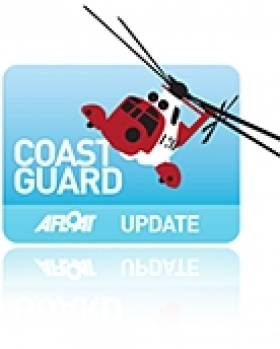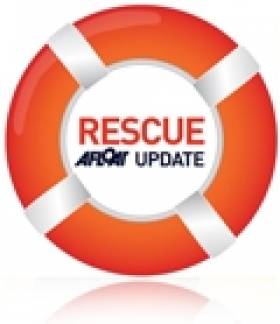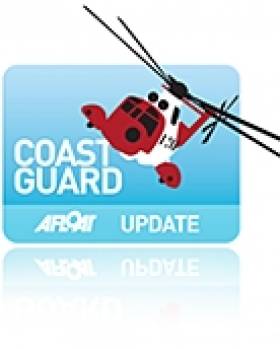Displaying items by tag: Coastguard
Coastguard Rescues Three Men from Angling Boat
#RESCUE – Three men were rescued from an angling boat they had just bought when it broke down in the Menai Strait.
Holyhead Coastguard received a 999 phone call from one of the men on board the 28 foot boat at just after midnight today. He explained that the engine had cut out and they were drifting towards rocks.
Because the crew weren't sure exactly where they were Penmon, Bangor and Llandwrog Coastguard Rescue Team were sent to the area. The RNLI inshore lifeboat from Beaumaris and the All weather lifeboat from Porthdinllaen were asked to attend alongside the RAF rescue helicopter from Valley. Using the blue flashing lights from Coastguard vehicles Holyhead Coastguard were able to establish their exact location. The crew were lifted to safety and taken to hospital by the rescue helicopter. The Beaumaris lifeboat towed their vessel ashore to Caernarfon.
Barry Priddis Holyhead Watch Manager said:
"This crew had recently bought to boat but what they hadn't acquired were waterproof clothing, lifejackets, flares or training in how to use a vhf radio. They also had no way of knowing where they were.
"Luckily there were in sight of land when the engine failed so they were able to make a mobile phone call but a fun fishing trip could easily have turned to tragedy.
"If you are buying a boat please think about the other equipment you'll need. We recommend that you wear a lifejacket at all times when on deck. These should be well maintained and have a sprayhood, light and whistle. You should also have DSC or vhf radio communications and know how to use it."
Second Cruiser in a Week Runs Aground in Lough Erne
#RESCUE - Four people were rescued on Lough Erne yesterday after their motor cruiser ran aground in the second such incident in a week, the Belfast Telegraph reports.
All on board were retrieved by RNLI lifeboat from the 29ft cruiser, which is believed to have stranded on rocks beyond the marked channel of the lough.
No injuries or damage to the vessel were reported, with a Northern Ireland Coastguard spokesperson describing it as "a routine rescue".
The coastguard blamed low water levels in the lough caused by lack of rainfall in Co Fermanagh.
Waterways Ireland has posted a marine notice warning boat users of the risks posed by "the extended period of unseasonal dry weather" for Ireland's inland waterways.
In a similar incident last Friday, three adults and two children were rescued from a cruiser that stranded in shallow water on the lough.
The Belfast Telegraph has more on the story HERE.
999 Calls Alert Coastguard to People Cut off By Tide
#COASTGUARD – Two people, along with their two dogs, had to be rescued after they became cut off by the tide whilst out walking at Far Arnside near North Morecambe.
At 11.10 this morning, Liverpool Coastguard received a flurry of 999 calls from concerned members of the public who could see the people out walking and reported that the tide was coming in around them. At 11.15 one of the pair involved rang Liverpool Coastguard to ask for help. He told the Coastguard that they were trying to make it to shore but being forced back by the water.
Liverpool Coastguard sent the Arnside Coastguard Rescue Team (who are equipped with rescue jet skis) to the scene, and requested the launch of the Morecambe RNLI lifeboat. With the water coming in fast around the pair, 999 calls continued to come into the Operations Room from worried members of the public ashore. The Coastguard Rescue Team located the casualties, who were by this time knee deep in water, and supplied them with lifejackets and prepared them for transferral into the lifeboat, which arrived at 11.50. Liverpool Coastguard also called an ambulance, which was waiting ashore and checked over the two people, who were deemed to not require medical attention.
Graham Parr, Watch Manager, Liverpool Coastguard said:
"The spring tides present at this time of year bring tides that are both higher, and stronger, than usual, and so it is even more important that people check the tide times before they venture out on a walk. Of course, in this location, we also have the Arnside bore, a tidal bore that brings fast flowing water that can be perilous for anyone on the beach during an incoming tide."
Fishing Vessels Drift in Bad Weather at Fishguard
Severe weather has caused four fishing vessels and a yacht to break from their moorings in Fishguard Harbour.
The first report of a fishing vessel that had broken its moorings was received by Milford Haven Coastguard at just yesterday morning when the northeasterly wind was gusting to gale force 9 /10. The fishing vessel 'Pisces' had been moored near the inner breakwater at Fishguard Harbour and had broken free. A crew member from the 'Cariad M' boarded the vessel and managed to restart the engine and take it to a safe place.
The Coastguard then received four further calls about fishing vessels that had broken free from moorings including the vessel 'Jay-C' that was beached near the Seaview Hotel, Fishguard. The 'Euroclydon' broke down when it was leaving its moorings in the harbour. It was swept on to the rocks. The 'Megan M' used their RHIB the 'Cariad M' to get a line aboard the 'Euroclydon' until the Fishguard RNLI all-weather lifeboat could reach the scene and tow the 'Euroclydon' to safety.
The lifeboat then checked the other moorings in the harbour and reported the fishing vessel 'Helen D' as missing from her mooring. She was subsequently found wrecked on the shoreline of Fishguard Harbour. The 'Cariad M' then came to the assistance of the yacht 'Coral Wind' who had been anchored in the harbour and had come adrift.
Mike Rogers, Milford Haven Watch Manager said:
"I'd like to thank the 'Megan M' and the 'Cariad M' for coming to the assistance of vessels in the harbour today in extremely challenging conditions. Their work was a reflection of true maritime spirit."
Coastguard Reminds Divers to Stop
After two divers suffered decompression sickness this weekend following rapid ascents, HM Coastguard have reminded all divers of the importance of regular stops as they come to the surface.
In the first incident Milford Haven Coastguard received a 999 call from Swansea Divers reporting that one of their divers was suffering decompression sickness on Dale Slipway Pembrokeshire. The Duty Diving Medical Officer gave advice and Dale Coastguard Rescue Team provided initial first aid. The diver was taken to the hyperbaric chamber in Plymouth by the RAF Rescue helicopter based at Chivenor.
In the second incident at just after 1.15pm Plymouth diver called MRCC Brixham to tell them that one of their divers was possibly suffering from a decompression problem after missing stops while diving at St Johns Lake, Plymouth. Following medical advice the diver was taken by ambulance to the hyperbaric chamber.
H.M Coastguard advises that dives requiring decompression stops should be planned beforehand and taken. Any diver who has missed planned decompression stops could suffer from decompression illness
Divers are also advised to make sure they are adequately qualified and experienced for the dive they plan to undertake and keep a close eye on weather and sea conditions. Their personal fitness is a top priority for safe diving and they should be familiar with new or different gear before planning deep dives.
If you are operating a dive boat check do a radio check with the Coastguard before heading out and tell the Coastguard your planned destination and expected return time. If one of your divers has a problem contact the Coastguard straightaway.
Coastguard Helicopter Gets State-Of-The-Art Imaging Systems
#COASTGUARD - Canada's L-3 Wescam has announced it will be providing electro-optical and infrared imaging systems for the Irish Coast Guard's revamped search and rescue helicopter fleet, starting with the new Sikorsky S-92 based at Shannon.
“This order pairs the most modern SAR helicopter with the most advanced EO/IR sensor to provide a vital capability for lifesaving missions,” said Paul Jennison, vice president of government sales and business development for L-3 Wescam.
The company describes its MXTM-15 system as a one-line replacement unit solution, which reduces installation weight by 25% and increases much-needed cabin space for transporting rescue victims.
The system’s digital infrared camera is capable of a 20% increase in visual range, allowing missions at night or in inclement weather to result in a higher search success rate.
In addition, the system comes with WESCAM’s MX-GEO Gen 3 software package which helps deliver maximum geographic location accuracy and significantly reduces operator fatigue that often arises in demanding and stressful SAR operations.
Imaging system upgrades are expected to be rolled out across the Irish Coast Guard's helicopter fleet by the end of next year.
Angler Dies After Lough Corrib Incident
#RESCUE - One angler has died in hospital and another was receiving emergency treatment last night after their boat got into difficulty on Lough Corrib.
According to The Irish Times, the two men were among a party of three on a boat that was struck by a wave off Annaghdown, which knocked one of them into the water.
Though he was reportedly wearing a lifejacket before he went overboard, an empty jacket was then spotted floating on the surface. One colleague entered the water to search for him but was unsuccessful.
Responding to the distress call from a nearby angling boat, the Irish Coast Guard's Shannon helicopter located the missing angler soon after arriving on scene, some 50 minutes after he entered the water.
The man was airlifted to University Hospital Galway, with the coastguard chopper returning for his colleague when he showed signs of hypothermia.
A small craft warning from Met Éireann was in effect throughout the area at the time of the incident.
The Irish Times has more on the story HERE.
Unified EU Coastguard On The Cards
#COASTGUARD - Greater co-operation between Europe's coastguard organisations is inevitable, according to the Irish Coast Guard director.
Chris Reynolds was speaking at Search and Rescue 2012, the EU Heads of Coastguard conference in Dublin last Thursday, at which he outlined a feasibility study being conducted by the European Commission on a standardised coastguard service across Europe.
As Shephard Media reports, Reynolds admitted that some challenges stood in front of any effective change in the sector, noting that SAR policy at member state level is often spread across many departments.
But the Costa Condordia disaster off the Italian coast recently may focus governments to develop a "sense of urgency" on the issue, he said.
In the keynote address at the conference, Italian coastguard chief Giuseppe Troina said it was fortunate that the death toll in that incident had not been much greater, emphasising that more than 4,000 people survived the cruise ship's sinking.
The Irish Times has more on the story HERE.
Search for Bait Diggers Lost in Fog
#COASTGUARD – In two separate incidents last night Liverpool Coastguard sent resources to assist people after they became lost in fog whilst on the beach.
The first call came at 8.00 pm from a man who had been bait digging at Formby Point in Merseyside.
The fog had descended quickly and he had found himself unable to find his way back, and unable to give his position. Liverpool Coastguard sent the Crosby Coastguard Rescue Team, quad bikes from Southport Independent Rescue and teams from Mersey Fire and Rescue Service and Merseyside Police to the scene. They also maintained telephone contact with the man for the duration of the incident, asking him to listen for the resources that were searching for him and describe the location of any sounds. They also asked vessels entering the river to sound their foghorns, again to assist with pinpointing the man's location. Although the tide had been going out at the time of the man's initial call, as resources searched, the tide began coming in around him, making the search even more urgent.
At 9.15 pm, the man reported to Liverpool Coastguard that he could see the lights of a Police Land Rover and a quad bike, and so he was met by rescue crews and escorted safely off the beach.
Just after the previous incident had closed, at 9.29 pm, Liverpool Coastguard received a call from a man who had also been out bait digging, this time at Blackpool. Again, he had lost his way in the fog and the tide had begun coming in around him. Liverpool Coastguard sent the Lytham Coastguard Rescue Team and requested the RNLI send their tractor from Lytham to assist in the search, along with requesting they launch the Blackpool Inshore Lifeboats. Luckily, at 9.35 (just as the lifeboats were launching), the man phoned to say that the fog had lifted sufficiently for him to make his way back to the road, and the rescue resources were stood down.
Liverpool Coastguard Watch Manager Paul Parkes said:
"Having also dealt with an incident last week where a father and son became lost in fog and had to be treated for severe hypothermia, the risks of being out on the coast when fog descends are all too clear. We would encourage members of the public to always check the weather forecast before they go out onto the coast for any activity, and stay away from the beach when fog is forecast."
Walkers Rescued at West Kirby
#COASTGUARD – Two walkers have been rescued from the water at West Kirby on the River Dee estuary after a three hour ordeal, lost in fog.
Liverpool Coastguard received a 999 call from the pair at 5.10pm reporting that they had set off for a dog walk out on the sands near Hilbre Island but thick fog had come in and they became disorientated and lost. The tide was coming in and it was dark at 5pm so combined with foggy conditions the visibility was very poor.
Liverpool Coastguard initiated a search of the area involving Hoylake and Newbrighton Coastguard rescue teams, West Kirby RNLI inshore lifeboat and the Hoylake lifeboat tractor. The rescue helicopter from RAF Valley also began a search of the area but foggy conditions prevented them continuing.
The Merseyside Coastguard Sector Manager was able to keep talking with them by mobile phone but visibility was less than 20 metres and the pair reported that they were up to their waists in water with the incoming tide. At 8pm the shore crew of the West Kirby RNLI lifeboat heard them shouting and the inshore lifeboat was guided in to recover the two males and their dog from the water and transfer them to a waiting ambulance. The pair are a father and son and were reported to have been suffering from severe hypothermia.
Liverpool Coastguard Watch Manager Graham Parr says,
"These large stretches of sand and channels can be treacherous so always check weather and tides before you set off and ensure you leave plenty of time to get back to shore before darkness. Unfortunately these walkers were caught out by thick fog today."


























